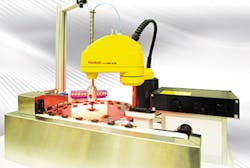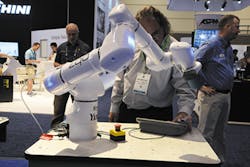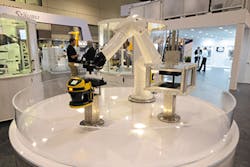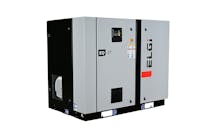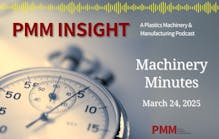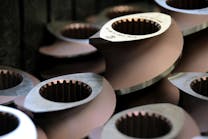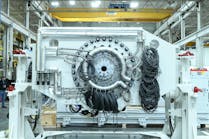Robots performing a variety of applications were hard at work at NPE2018. They included collaborative robots, models designed to work with injection molding machines and models featuring new communications and Industry 4.0 capabilities.
FANUC FEATURES SCARA AND PAINTING ROBOTS
The latest additions to Fanuc America's portfolio include SCARA robots and a unit made specifically for painting.
The company demonstrated its new SR-3iA SCARA robot, which can perform a variety of functions, including assembly, testing and packaging. A compact, lightweight design provides significant space savings, it said.
At the show, the robot exhibited high-speed pick-and-place abilities. A second SR-3iA, equipped with Fanuc's iRVision vision products and iRPickTool software, demonstrated visual circular tracking.
Visual circular tracking allows for a compact system layout and eliminates unnecessary parts handling, which minimizes potential product damage. The SCARA robot on display was able to pick up parts from a rotating disc and place them on a conveyor. According to the company, a robot in such a setup can handle as many as 115 parts per minute.
IRVision employs a camera that allows a robot to know the precise location of a part and inspect it.
"Our new SCARA robots represent the next level of speed and precision for assembly and material-handling applications," said Nishant Jhaveri, engineering manager for small and SCARA robots. "Withthe addition of SCARA robots to our small-robot lineup, we're able to provide customers with a cost-effective solution to achieve higher productivity, even when micron-level tolerances are required."
The SR-3iA has a 6.6-pound payload, 15.7-inch reach and 7.87-inch stroke.
In addition to the two SR-3iA robots on display, Fanuc had information about the SR-6iA SCARA robot, which also is new. The SR-6iA has a 13.2-pound payload, 25.6-inch reach and 8.3-inch stroke.
Fanuc also demonstrated its P-40iA paint robot, which debuted late last year. The robot simulated painting plastic parts using coordinated motions to reach all surfaces.
The P-40iA offers a variety of mounting positions, such as on the floor, upside down or on the wall, which helps in small and narrow workspaces. It's also easily adaptable to changing lot sizes, new styles and other modifications to the parts it paints. It has a 51.2-inch reach and 11-pound payload. Its arm is pressurized and purged of air and is FM- and ATEX Class Division 1-approved. The latest R-30iB Mate Plus controller for the robot features an intuitive iPendant with enhanced screen resolution and more processing capability compared with previous versions. It supports Fanuc's iRVision and PaintTool software. An IP67-compatible rating allows operation in factories with dust and oil mist, the company said.
YUSHIN INTRODUCES FRA TAKE-OUT ROBOTS
Yushin's new FRA take-out robots incorporate new technologies that make them more agile, smarter and faster than previous take-out robots, the company said.
"There are several new features on this robot," said Michael Greenhalgh, director of operations. "One of the ones I am most impressed with is the active vibration control."
Active vibration control reduces the time a robot has to wait after the mold opens to remove the part.
"It is very similar to what you have with noise-canceling headphones," Greenhalgh said. "Vibration is a sound wave. When you use noise-canceling headphones, it is a sine wave that is equal and opposite and cancels out the vibration. You'll see that device actually has a cylinder in it, and it actually vibrates equal and opposite to minimize the vibration in the mold."
In addition to the vibration-control feature, the FRA robots incorporate arc motion control, which allows them to start rounding off corners when the arm is moving. The classic movement pattern is square, Greenhalgh said.
"Obviously, everybody is pushing to mold more and more parts and shorten cycle times," he said. "So, we've added a feature called arc motion [control] so the robot will start rounding the corners. Rounding the corners shortens the cycle time outside the mold."
A third new feature is adaptive motion control, which automatically optimizes robot motions to ensure smooth operation that minimizes vibration.
In combination, the three features allow the FRA robots to achieve cycle times up to 10 percent faster than their predecessors.
FRA robots also come equipped with the new E-touch V controller, which is compact and fits comfortably in the user's hand. It has new tap and swipe features similar to those found on smartphones and tablets. It also includes a feature that splits the screen layout to improve robot teaching without the need to switch between screens.
Another optional feature on the new FRA robots is the Yushin Intu Line, a new Industry 4.0 technology that allows for continuous monitoring of robots' performance. FRA robots have the ability to transmit information through a cellular network to the cloud for continuous monitoring of performance via the internet.
Processors can remotely monitor the performance of all Yushin FRA robots in their operation. The data can be viewed via web browser on a tablet or smartphone. The information, which includes production counts and average cycle time, can also be shared with Yushin for help with troubleshooting. All the information is stored securely, the company said.
The FRA robots also include newly designed end-of-arm tooling (EOAT) that comes standard. The numerical control servo wrist units, which are patent-pending, feature servo motors with eight axes of movement. The numerical control servo wrist units enhance automation and production efficiency, Yushin said.
The units are about 50 percent thinner than previous numerical control servo wrist units from Yushin. Complex motions can be easily set up and adjusted with the new E-touch V controller.
Yushin also announced at NPE2018 that it signed an exclusive distribution agreement with Productive Robotics, which last year began manufacturing the OB7 collaborative robot. The cobot is manufactured in Carpinteria, Calif.
A partnership between Yushin and Productive Robotics is a natural fit because the OB7 is suited to different tasks than Yushin's industrial robots, company officials said.
"The collaborative robot isn't replacing the Yushin robot for taking parts out of the mold," said Zac Bogart, president of Productive Robots. "It is taking parts from the Yushin robot and doing the final packaging or assembly."
The OB7 has seven axes and is equipped with sensors that make it safe to work beside people in tight spaces without the need for safety fencing. The seventh axis gives the OB7 the flexibility and dexterity to reach around objects in confined spaces, unlike six-axis collaborative robots.
"It works really good for downstream work — doing kitting or putting pieces into a box," Greenhalgh said. "You could have your Yushin high-speed take-out robot picking the parts and placing them on the station, and have this robot picking them up and boxing them."
The OB7 learns to do jobs with no programming or complicated coding. It features an 11-pound payload and a 3.3-foot reach with 0.1mm accuracy.
Yushin and Productive Robotics officials said the cobot is suitable for:
• Loading, unloading and part removal;
• Machine tending and batch production;
• Gluing, painting and welding;
• Polishing, cutting, deburring and grinding;
• Packaging and pelletizing; and
• Quality control measuring, testing and inspection.
The OB7 can be equipped with a variety of end effectors, including servo grippers, pneumatic grippers and vacuum tools.
STAUBLI CLEAN-ROOM ROBOT
Stäubli showcased its TX2-60 Super Cleanroom collaborative robot, which was introduced late in 2017.
NPE2018 marked the first time the SuperCleanroom version of the cobot was shown in the United States.
"It's a robot for single-use medical device injection molding and assembly processes in a sensitive environment," said Olivier Cremoux, North American business development manager for Stäubli.
The TX2-60 SCR meets ISO 2 standards for minimizing particle emissions. The robot has:
• A smooth coating that is different than that used on the standard robot; all surfaces are coated prior to assembly to ensure full coverage;
• A pneumatic circuit inside its arm that is under vacuum to prevent emissions of potential particles;
• Upgraded seals that limit the release of particles.
It is suited for environments in which plastic medical devices, electronics, pharmaceuticals or food products are handled, Cremoux said.
It can be used to load inserts or labels in injection mold cavities, remove parts and assemble or package parts. If equipped with a visual system, it can be used for parts inspection.
"It's not just machine tending," Cremoux said. "It's machine tending plus the possibility for secondary processes and collaboration in a clean-room environment. It's the best way to optimize your molding machine cycle time."The TX2-60 is a six-axis robot with a 2.2-foot reach and 0.02mm repeatability. It can handle up to a 19.8-pound payload. All cables and pipes are routed through the robot's arm. The robot can be mounted on the floor, wall or ceiling.
RANGER BUIDLING LARGEST ROBOT IN NORTH AMERICA
Ranger Automation Systems announced at NPE2018 that 20/20 Custom Molded Plastics, Holiday City, Ohio, selected it to design and build a new robot for a Cincinnati 6600 injection molding machine (IMM) from Milacron that 20/20 will install later this year.
The IMM is the largest machine produced by Milacron, and it was highlighted at NPE2018. It has 6,745 tons of clamping force.
The new Ranger RT-6000-S10 robot, which will work with the Milacron press, will be the largest robot built in North America, with an 18-foot vertical travel and 12-foot reach on each of its two five-axis robotic arms, which share a common beam, the company said.
With a payload capacity of 400 pounds, the robot arms can extract parts up to 10 feet wide or 10 feet tall, independently or in tandem, from either the moving or stationary platen. The robot also can be used with stack molds.
The RT-6000-S10 represents a design progression from the RT-3000 dual-arm robots currently running on 20/20's Uniloy structural foam molding machines.
Ranger has a longtime relationship with 20/20.
"We have a 15-year history of supplying robots to them," said John Campbell, Ranger national sales manager. "The RT-6000 will be 50 percent larger than our RT-3000 dual-arm robots currently running on their Uniloy structural foam machines, so this will be the largest robot they have by far."
20/20 specializes in molding plastic parts many others can't, President Ron Ernsberger said.
"We chose Ranger back in 2002 or 2003, and we primarily chose them because of their ability to build the large robots we need to run our equipment," Ernsberger said. "They told us what they felt they could do, why the robots would benefit us, and they pretty much hit it out of the park. They did what they said. The robots performed the way they said they would. The robots performed flawlessly."
Ranger is scheduled to deliver the new robot in September. It also will be available to other customers.
Ranger Automation has been designing and building robots for 30 years for injection molding, blow molding, extrusion, thermoforming and material handling.
SHINI DISPLAYS FIVE-AXIS ROBOT
Shini displayed a five-axis robot that recently became available in the U.S. The standard Shini ST3 is a three-axis traversing robot, but the five-axis version is equipped with an end-of-arm wrist that adds A-axis and C-axis movements. The wrist features two servo motors that add "flip" and rotation motions, Shini said.
The display model, an ST3-1400-2000-M-T-AC EM12, featured a 55-inch vertical stroke, a 78-inch horizontal stroke and a payload of 33 pounds.
The robot is designed for rapid and precise removal of parts from injection molding machines.
Bruce Geiselman, senor staff reporter
bgeiselman@plasticsmachinerymagazine.com
Contact:
Fanuc America Corp., Rochester Hills, Mich., 888-326-8287, www.fanucamerica.com
Productive Robotics Inc.,
Carpinteria, Calif., 805-244-9300,www.productiverobotics.com
Ranger Automation Systems Inc.,
Millbury, Mass., 508-865-0151,www.rangerautomation.com
Shini USA, a division of Budzar Industries Inc., Willoughby, Ohio, 440-918-0505, www.shiniusa.com
Stäubli Corp.,
Duncan, S.C., 864-486-5421,www.staubli.com
Yushin America Inc.,
Cranston, R.I., 401-463-1800,www.yushinamerica.com
Bruce Geiselman | Senior Staff Reporter
Senior Staff Reporter Bruce Geiselman covers extrusion, blow molding, additive manufacturing, automation and end markets including automotive and packaging. He also writes features, including In Other Words and Problem Solved, for Plastics Machinery & Manufacturing, Plastics Recycling and The Journal of Blow Molding. He has extensive experience in daily and magazine journalism.

